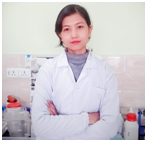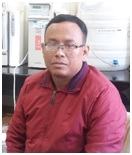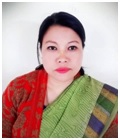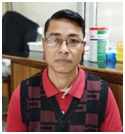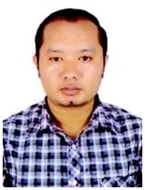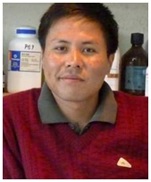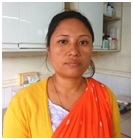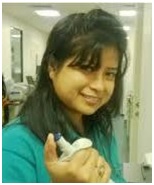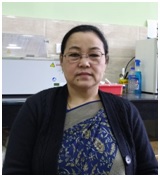
Huidrom Sunitibala Devi
Huidrom Sunitibala Devi, PhD
Designation/Position: Scientist-E
Department/Programme Name: Plant Bioresources Division
Academic Qualifications
• May 2015 – Nov 2015, Post-Doctoral, DBT-Overseas Associateship, Citrus Research and Education centre, University of Florida, USA
• 1992-1999, Ph.D, Manipur University, Manipur
• 1990-1991, M.Sc Life sciences (Botany, specialization in Genetics) , Manipur University, Manipur
Experience
• 1st July 2019 till date, Scientist-E , Institute of Bioresources and Sustainable Development, Imphal
• 24th July 2013- 30th June 2019, Scientist-D , Institute of Bioresources and Sustainable Development, Imphal
• 24th July 2008- 23rd July 2013, Scientist-C , Institute of Bioresources and Sustainable Development, Imphal
• 24th July 2004- 23rd July 2008, Scientist-B , Institute of Bioresources and Sustainable Development, Imphal
• 2nd May 2000 – 22nd July 2003, Research Associate, Department of Life Sciences, Manipur University, Imphal
• 1992- 1998, Junior Research Fellow, Department of Life Sciences, Manipur University, Imphal
Awards & Fellowships
• 2000: Research Associateship, awarded by Council of Scientific and Industrial Research, New Delhi for three years April 10.
• 2014: Awarded overseas Associateship for the north Eastern Region, awarded by Department of Biotechnology, Government of India for 6 (six) months
• 2016: Awarded Newton-Bhabha Fund: UK-India Programme for Women in Plant and Crop Sciences, part of the bilateral collaboration between Department of Biotechnology, Ministry of Science and Technology - Cambridge University, UK for Female Leadership in Crop and Agricultural Sciences, held at Clare College Cambridge.
Memberships (Professional Associations / Societies)
• Life Member, The Biotech Research Society, India [BRSI]
• Life Member, Indian Society of Translational Research, India [ISTR]
• Life Member, The Indian Science Congress Association, India
• Member, Indian Society of Cell Biology, India
• Member, International Society for Horticultural Science [ISHS]
PhD’s Guided
• Rakesh Sanabam, 2009-2015 - In vitro production of disease free Khasi mandarin (Citrus reticulata Blanco) through shoot-tip grafting and molecular profiling of Citrus rootstocks of Northeast India, Guwahati University
• Ph. Baleshwar Sharma, 2010-2015 - Evaluation of antioxidant properties, profiling of organic acids and phenolic compounds of five wild fruits of Manipur, India and micropropagation of selected species, Guwahati University
• W. Amuchou Singh, 2010- 2015 -Assessment of local banana cultivars (Musa spp.) of Manipur using biotechnological tools, Guwahati University
• Sila Moirangthem, 2011-2016 -Identification and characterization of Citrus reticulata scion using biochemical and molecular markers and screening of rootstocks tolerant to Phytophthora, Guwahati University
• NC Lenbi, 2012-2018 - Isolation, Characterisation and expression studies of Fusarium resistance gene candidates from Zingiber spp. of north eastern India, Guwahati University
Specialized Training
• Participated Training-cum-Workshop on “Plant Genomics 2006 Application of DNA Based Molecular Markers for Crop Improvement” at NCPGR, New Delhi from March 16-29, 2006.
• Undergone Hands-on Training on “Virus indexing through ELISA Technique” at NBPGR, New Delhi from 30th march 2006 to 6th April, 2006.
• Undergone hands on training on Real Time PCR at the state-of-art Genomic and Proteomic training facility for LABINDIA at Gurgaon, India, March 11-13, 2008
1. Research Theme Photo
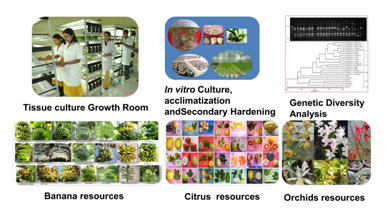
2. Verticals involved
Tissue culture facility for maintenance of potentially endangered/endangered plant biodiversity and supply of disease free planting material for locally important plants.
3. Research Area/Research Expertise
Plant Tissue Culture & In Vitro conservation of Selected Medicinal, Aromatic and Horticultural Plant Resources for Sustainable Utilization.
4. Research Summary
A. Current Research:
• Huanglongbing in Manipur: Distribution, incidence, molecular characterization and its importance in the management of local citrus fruits.
Description: Presently, we are focusing on ‘Huanglongbing’ (HLB) or citrus greening in local citrus fruits of Manipur. HLB is the most severe and devastating disease of citrus worldwide, caused by ‘Candidatus Liberibacter spp. It is a phloem-limited, unculturable, graft- transmissible gram-negative bacterium vectored by the Diaphorina citri, the Asian Citrus Psyllid. It affects almost all citrus cultivars, ultimately leading to the death of the tree. In this study, we detected HLB in various commercially grown citrus varieties collected from different citrus-growing areas of Manipur. We characterized the causal bacterium and also analyze the incidence and distribution of HLB in different citrus orchards of Manipur which will help at developing a management strategy for HLB infected plants. Identification of the key genes and proteins induced by HLB in leaf tissue genes and candidate genes associated with plant defense is under process to provide information for HLB management.
• Species delineation and evaluation of ethnomedicinally important Kaempferia L., (Zingiberaceae) species in North-east India using ideal molecular markers. In-vitro propagation of Kaempferia species: a conservation strategy
Description: An extensive survey was conducted covering all the districts of Manipur. Altogether a total of 20 samples belonging to genus Kaempferia have been collected. The collected germplasms were maintained (after giving proper accession numbers) both in the Poly-house and field gene bank of IBSD, Imphal for further investigation. A preliminary study based on the earlier publications able to conclude that the collected Kaempferia species belong to four different species viz: K. galanga, K. marginata, K.parviflora, and K.rotunda. During our collection, a few possible hybrids showing both qualitative and quantitative characters of K. galanga and K. marginata were found. Global Positioning System (GPS) coordinates record, addresses of the collection area, phone numbers of traditional practitioners, traditional knowledge and uses of different tribes and communities were also recorded for future references and study. Further survey and collection are planned in this season because its occurrence is restricted to certain areas. This will also aim to locate its natural habitat.
• Conservation of rare and endangered taxa of Vandeae tribes of Manipur, NE India and production of their hybrids using Biotechnological tools.
Description: Vandeae, a large horticulturally important group of Orchidaceae family contains 1,700 - 2,000 species in more than 150 genera. The classification of taxa within this tribe is still largely based on floral morphology. With the recent spate of molecular data, evolutionary relationships among orchids are being re-established and re-circumscribed. These orchids are pantropical epiphytes and found in tropical Asia, Australia, The Pacific Islands, and Africa. A field survey was done at six districts of Manipur so far. In-vitro conservation of germplasm, determination of compatibilities of different crosses and reciprocal crosses from the collected samples will be performed.
B. Previous Notable Research:
• Biotechnology tools for conservation of rare and endangered orchids and production of their hybrids
Description: The great popularity of hybrid orchids is due to a variety of reasons like superior quality, ease of cultivation, free blooming habit, compactness, hardiness and the incredible array of shapes, blend of colours and longer shelf-life. Orchids are slow propagative in nature. Application of tissue culture technology will be highly helpful for the rapid diffusion of new hybrids to the commercial enterprise. The aim of this project was collection and preservation of selected rare/endangered orchids for determination of compatibilities of different crosses and reciprocal crosses. Development of tissue culture protocols for axenic seed/shoot tip culture and hardening of plantlets of parent orchids and their hybrids. With advent of molecular biology, many breeders have employed DNA based molecular markers. Development of DNA fingerprint for the species, landraces and hybrids for hybridity confirmation of orchid species was another objective of the project. Phylogenetic relationship amongst 20(twenty) taxa of the tribe Vanda (Orchidaceae) was studied based on chloroplast trnL (UAA) intron sequence and the nucleotide sequences obtained were deposited to NCBI GenBank
• In vitro production of disease free Khasi mandarin (Citrus reticulata Blanco) through shoot-tip grafting and molecular profiling of Citrus rootstocks of Northeast India, carried out at IBSD, Imphal
Description: Protocol for production of disease free foundation block of “Khasi” mandarin and different factors affecting the shoot tip micrografting was standardized. Two types of incision (inverted-T and wedge cut) at the decapitated portion of rootstock were studied, inverted-T cut gave better response compared to wedge cut. Research on micrografting also reveal that STG was affected by the concentration of sucrose with optimum being obtained at 6% of the four different concentration (1.5, 3, 6 and 9 %) compared. Further, the scion size influenced the rate of micrografting with 0.65-0.75 mm size giving better response in STG. Cytokinin concentration has also direct influenced in growth of the scion with better growth obtained in 1mg/l compared to 0.5mg/l BAP (benzyl amino purine).
Molecular and serological techniques for indexing of the plantlets produced by STG have been standardized. ELISA technique for detection of graft transmissible virus ctv was performed for plantlets of more than 9-10 months old obtained by STG. Since disease indexing using serological technique is influenced by various limitations, reverse transcription (RT-PCR) PCR was also being standardized using two different primers. cDNA prepared from the RNA extracted from samples and symptomatic mother plants have been used for PCR amplification using two primer pairs CTV P25F & CTV P25R and PM50 & PM 51 giving 509 bp and 697 bp in the mother plants while no amplification was observed in the micrografted plants.
• Assessment of local banana cultivars (Musa spp.) of Manipur using biotechnological tools, carried out at IBSD, Imphal
Description: The states of north-eastern region of India are home to several wild and cultivated bananas. There is a dearth of information on the genetic diversity of Musa resources of the region to assist in crop improvement programmes. Twenty-five genotypes of Musaceae accessions including one Ensete species maintained at Institute of Bioresources and Sustainable Development (IBSD), Imphal, were characterized based on 60 morpho-taxonomic characters and seven inter-retrotransposon amplified polymorphism (IRAP) primer combinations. The morphological data were presented in the form of hierarchical clusters and principal components. Hierarchically, the Musa genotypes can be grouped into distinctive clusters, and while the first four principal components could explain 58.66 % of variation of the total morphological traits studied. A total of 337 amplicons were generated using 12 IRAP primer combinations with an average percentage polymorphism of 96.12. The molecular markers used in this study could reveal intra- and inter-group diversity among the genotypes with similarity coefficients ranging from 0.16 to 0.90. It could also differentiate the clusters of all the edible cultivated Musa genotypes from the wild/semi-wild ancestors. Thus, the chosen parameters seem to be especially important in the varietal or genotype identification.
• Evaluation of antioxidant properties, profiling of organic acids and phenolic compounds of five wild fruits of Manipur, India and micropropagation of selected species, carried out at IBSD, Imphal
Description: Antioxidant properties, physico-chemical characteristics and proximate composition of five wild fruits viz., Garcinia pedunculata, Garcinia xanthochymus, Docynia indica, Rhus semialata and Averrhoa carambola grown in Manipur, India were presented in the current study. The order of the antioxidant activity and reducing power of the fruit samples was found as R. semialata > D. indica > G. xanthochymus > A. carambola > G. pedunculata. Good correlation coefficient (R2 > 0.99) was found among the three methods applied to determine antioxidant activity. Total phenolic content was positively correlated (R2 = 0.960) with the antioxidant activity however, total flavonoid content was not positively correlated with the antioxidant activity. Physico-chemical and proximate composition of these fruits is documented for the first time.
A. Research Articles
1. Rakesh S, N Samarjit Singh, Dinabandhu Sahoo, H Sunitibala Devi (2018): Genetic relationship of rough lemon landraces and under-utilised citrus
genotypes from North-East India revealed by SSR and RAPD markers, Trees, https://doi.org/10.1007/s00468-018-1694-z, (Impact Factor- 1.78)
2. Rakesh S, N Samarjit Singh, P J Handique, H Sunitibala Devi (2015): Disease-free khasi mandarin (Citrus reticulata Blanco) production using in
vitro microshoot tip grafting and its assessment using DAS-ELISA and RT-PCR (Springer). Scientia Horticulturae (Springer), 189 (2015) 208–213. (Impact Factor – 1.504)
3. Warepam Amuchou Singh, Nandeibam Samarjit Singh, Pratap Jyoti Handique and Huidrom Sunitibala Devi (2014): Morpho-taxonomical and molecular
assessment of Musa genotypes from north-east India by morphological and interretrotransposon amplified polymorphism markers. Plant Syst Evol. DOI 10.1007/s00606-014-1094-9. (impact factor – 1.154)
4. Thingbaijam Dikash Singh, Khumallambam Devala Devi and Huidrom Sunitibala Devi (2014): Horticultural Performance of Conventional and Micropropagated Plants of Zingiber officinale from Manipur, Northeast India. PHILIPP AGRIC SCIENTIST, Vol. 97 No. 3, 114 -118 (impact factor – 0.368).
5. Thingbaijam Dikash Singh and Huidrom Sunitibala Devi (2014): Effect of silver nitrate during ex vitro acclimatization of micropropagated ginger var. Nadia and Baishey. Notulae scientia biologicae 6(1):82-84 (impact factor- 0.6)
6. Huidrom Sunitibala Devi, Sanglakpam Irabati Devi, Thingbaijam Dikash Singh (2014): High Frequency Plant Regeneration System from Transverse Thin Cell Layer Section of In vitro Derived ‘Nadia’ Ginger Microrhizome. Notulae Scientia Biologicae 6(1):85-91 (impact factor-0.6)
7. Thingbaijam Dikash Singh, Lalleima Chakpram and Huidrom Sunitibala Devi (2014): Induction of in vitro microrhizomes using silver nitrate in Zingiber officinale var. Baishey and Nadia. Indian Journal of Biotechnology, Vol 13, April 2014, pp 256-262. (impact factor – 0.51)
8. S. Subbarayudu, B. Shankar Naik, H. Sunitibala Devi, B. S. Bhau, P. Shaik Sha Valli Khan (2013) Microsporogenesis and pollen formation in Zingiber officinale Roscoe, Plant Systematics and Evolution, DOI 10.1007/s00606-013-0907-6, (Impact Factor-1.154)
9. Baleshwor Sharma & Pratap Jyoti Handique and Huidrom Sunitibala Devi (2013): Antioxidant properties, physico-chemical characteristics and proximate composition of five wild fruits of Manipur, India. J Food Science Technology (Springer) (Impact factor 2.024).
10. Huidrom Sunitibala Devi, Sanglakpam Irabati Devi, Thingbaijam Dikash Singh. [2013]: High Frequency Plant Regeneration System of Aerides odorata Lour. Through Foliar and Shoot Tip Culture. Notulae Botanicae Horti Agrobotanici Cluj-Napoca. 41(1):169-176. (Impact factor-0.652)
11. Warepam Amuchou Singh, Somkuwar Bharat Gopalrao, Thingnam Gourshyam, Pratap Jyoti Handique& Huidrom Sunitibala Devi. [2013]. DEBDOM: Database Exploring Banana Diversity of Manipur. 9(5): 270–273. (Impact factor-1.15)
12. Kh Punyarani, Kh Devala Devi, C Henary Singh, N Samarjit Singh, H Homen Singh, Th Dikash Singh, Sila Moirangthem and H Sunitibala Devi (2013): In vitro production of genetically stable and virus free plantlets of Musa sp. var. Meitei Hei using male inflorescence as explants. Scientia Horticulturae (Springer), 64: 440–447. (impact factor – 1.504)
13. Kh Nongalleima, Th Dikash Singh, Dey Amitabha, Lokesh Deb and Sunitibala Devi (2013): Optimization of surface sterilization protocol, induction of axillary shoots regeneration in Zingiber zerumbet (L.) Sm. as affected by season. Biological Rhythm Research (Taylor and Francis), DOI: 10.1080/09291016.2013.818196. (impact factor – 1.216)
14. Dikash Singh, Ch. Henary Singh, Kh. Nongalleima, Sila Moirangthem, H. Sunitibala Devi [2013]: Analysis of growth, yield potential and horticultural performance of conventional vs. Micropropagated plants of Curcuma longa var. Lakadong. African Journal of Biotechnology. 12(14):1604-1608. (Impact factor-0.57)
15. Dikash Singh, Lalleima Ch., H. Sunitibala Devi. [2013]. High frequency induction of in vitro microrhizome using different culture vessels and silver nitrate in Zingiber officinale Rosc. var. Baishey and Nadia. (2013). Indian Journal of Biotechnology. Reference number: IJBT/Auth/2012/2176 (accepted publication pending). (Impact factor-0.55)
16. Th Dikash Singh, Kh Devala Devi, Brojendro Singh S, Ch Brajakishor Singh and H Sunitibala Devi. [2013]. Assessment of genetic stability in traditional ginger cultivated in Manipur: North-East India base on molecular and chemical markers. Analytical Letters. DOI:10.1080/00032719.2013.814059 (Impact factor-1.019)
17. Baleshwor Sharma, Th. Dikash Singh, P. J. Handique, H. Sunitibala Devi. [2012]: Unambiguous identification of Garcinia xanthochymus (Clusiaceae) in Manipur, India. Nebio, 3(3): 8-12 (impact factor- 0.9).
18. Dikash S.Th, Devala D. Kh., Punyarani Ksh., Henary S.Ch., Brojendro S.S, Brajakishor S. C, Sunitibala D. H. [2012]: Silver Nitrate and Different Culture Vessels Influence High Frequency Microrhizome In Vitro and Enhanced Growth of Turmeric Plantlet During Ex Vitro Notulae Scientia Biologicae. 4(4):67-78. (impact factor- 0.6)
19. Rakesh Sanabam, Bharat Gopalrao Somkuwar, Gourshyam Thingnam, Sila Moirangthem, Pratap Jyoti Handique and Sunitibala Huidrom [2012]: CIBMAN: Database exploring Citrus biodiversity of Manipur. 8(17).PP 838-840. (Impact factor-1.15)
20. Rajkumar Kishor, Huidrom Sunitibala Devi (2009): Induction of multiple shoots in a monopodial orchid hybrid (Aerides vandarum f × Vanda stangeana Reichb.f) using thidiazuron and analysis of their genetic stability. Plant cell, Tissue and Organ Culture (Springer), DOI 10.1007/s11240-009-9506-1.(impact factor – 2.612)DOI 10.1007/s13197-013-1128-2. (impact factor -2.024 )
21. S. Sha Valli Khan, H. Sunitibala Devi, R.K. Kishor and B. Narashimha Rao [2009]: Micropropagation and some acclimatization characteristics on Centella asiatica (Linn.) Urban Indian J Plant Physiol. Vol. 14 Oct.-Dec. PP 353-359. Sunitibala, Rajkumar Kishor [2009]: In vitro propagation of Dendrobium transparens L. from pseudobulb segments. Indian Journal of Biotechnology. Vol 8 October. PP 448-452.(impact factor – 0.51)
22. Rajkumar Kishor, S. Devi, K. Jeyaram and M. R. K. Singh [2008]: Molecular characterization of reciprocal crosses of Aerides vandarum and Vanda stangeana (Orchidaceae) at the protocorm stage Plant Biotechnology Report [Springer] DOI 10.1007/s11816-008-0053-8 (impact factor- 1.6).
B. Review Articles (Only authorized publishers) – Recent First
Ligia Erpen, H. Sunitibala Devi, Jude W. Grosser, Manjul Dutt (2018) Potential use of the DREB/ERF, MYB, NAC and WRKY transcription factors to improve abiotic and biotic stress in transgenic plants, Plant Cell Tissue and Organ Culture, (Impact factor- 2.004).
C. Book Chapters – Recent First
Sharma PB, Handique PJ & Devi HS (2014) In vitro Determination of Antioxidant Activity by DPPH? Method: An Approach to Unify Anticipated Report on IC50. In: Current topics in Redox Biology McGraw Hill Education Private Limited, New Delhi. ISBN (13): 978-93-392-1420-3
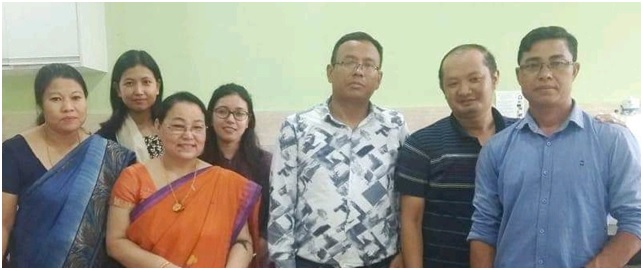
Group Members (Details):
|
1. |
Kangabam Soneja Devi, Ph.D-JRF, DST Inspire Fellow Problem addressing: Conservation of rare and endangered taxa of Vandeae tribes (Orchidaceae) of Manipur, NE India and production of their hybrids using biotechnological tools. Expected outcome: Conservation and hybrid production of rare and endangered taxa of Vandeae tribes of Manipur, NE India. |
|
|
2. |
Disianliu Gangmei, PhD-JRF, CSIR- JRF Problem addressing: Species Delineation and evaluation of ethno- medicinally important Kaempferia sp. using ideal molecular markers. In vitro propagation of Kaempferia sp : a conservation strategy. Expected Outcome: Complete survey and collection of Kaempferia species from different parts of Manipur and investigation of the phylogenetic relationships using morphological characteristics. |
|
|
3. |
Elangbam Julia Devi, PhD-SRF, IBSD-SRF Problem addressing: Huanglongbing in Manipur: Distribution, incidence, characterization and its importance in the management of local citrus fruits. Expected Outcome: To understand HLB distribution in Manipur and identify the key genes induced by HLB in leaf tissue genes and candidate genes associated with plant defence to provide information for HLB management |
|
|
4. |
Dr. N. Samarjit Singh, Senior Technical Officer (1), Core
|
|
|
5. |
S. Irabati Devi, Technician 1, Core
|
|
|
6. |
K. Sanjit Singh, Lab attendant, Outsourced |
|
|
Previous Members (Alumni) |
||
|
1. |
Rakesh Sanabam, PhD, Worked on - In vitro production of disease free Khasi mandarin ( Citrus reticulata Blanco) through shoot-tip grafting and molecular profiling of Citrus rootstocks of Northeast India Currently working at: ICAR, Lamphelpat as DBT RA |
|
|
2. |
Ph. Baleshwar Sharma, PhD Worked on - Evaluation of antioxidant properties, profiling of organic acids and phenolic compounds of five wild fruits of Manipur, India and micropropagation of selected species Currently working at: CAU, Sikkim as Assistant Professor |
|
|
3. |
W. Amuchou Singh, PhD Worked on -Assessment of local banana cultivars ( Musa spp. ) of Manipur using biotechnological tools. Currently working at: State Cooperative Department, Manipur |
|
|
4. |
Sila Moirangthem, PhD. Worked on - Identification and characterization of Citrus reticulata scion using biochemical and molecular markers and screening of rootstocks tolerant to Phytophthora . Currently working at: self employed |
|
|
5. |
NC Lenbi, PhD Worked on - Isolation, Characterisation and expression studies of Fusarium resistance gene candidates from Zingiber spp. of north eastern India Currently working at: self employed |
|
|
6. |
Dr. Rajkumar Kishor, DBT-PDF Worked on - Biotechnology tools for conservation of rare and endangered orchids and production of their hybrids. Currently working at: K&K Orchids, Imphal as Proprietor |
|
|
7. |
Dr. Tabitha Langhu, DBT-RA Worked on - Studies on the reproductive biology of Lilium mackliniae (Siroy lily), a threatened species and confirmation of the taxonomic identities of Lilium mackliniae and Lilium chitrangadae (Dzuku lily) through biotechnological intervention and conserving them in-situ and ex-situ. Currently working at: ICAR, Lamphelpat as Women Scientist |
|
|
8. |
Dr. Yumnam Silla Devi, DBT-RA Work on - Molecular targets and Binding Of [6]-Gingerol: A Structural Implication Using Molecular Modeling Study Currently working at : CSIR-NEIST, Jorhat.) as Scientist - C |
|
A. Core/Internal
a. Present: N/A
b. Past:
|
Sl. No. |
Duration (From-To) |
Title of Project/ Grant |
PI/Co-PI |
Funding Agency |
|
|
1 |
2017-2018 |
Breeding, micropropagation and cultivation of Dendrobium orchids |
Dr. H.Sunitibala Devi |
IBSD |
|
|
2 |
2017-2018 |
Propagation of disease-free varieties of selected banana species of North-East India through plant tissue culture for enhancing lively hood of local farmers. |
Dr. H.Sunitibala Devi |
IBSD |
|
B. Extramural:
a. Present: N/A
b. Past:
|
Sl. No. |
Duration (From-To) |
Title of Project/ Grant |
PI/Co-PI |
Funding Agency |
|
|
1. |
2008-2013 |
DBT Mission for Quality Planting Material Production and Utilization for the North-East No. BT/PR10369/PBD/16/783/2007. |
Dr. H.Sunitibala Devi |
DBT |
|
|
2. |
2010-2013 |
Identification of location specific ginger and turmeric varieties, quality planting materials production, insect pest and disease management, chemical profiling and development of value added products for socio-2economic development of N.E. region. No. BT/PR7861/NDB/51/114/2006. |
Dr. H.Sunitibala Devi |
DBT |
|
|
3. |
2008-2011 |
Prospecting Zingiber zerumbet for Molecular Resources. (No. BT /PR11 1 68/NDB/51/185/2008. DBT, Govt. of India. |
Dr. H.Sunitibala Devi |
DBT |
|
|
4. |
2011-2014 |
Biotechnological interventions for production of androgenic haploids to speed and support breeding of ginger. BT/34/NE/TBP/2010. DBT, Govt of India. |
Dr. H.Sunitibala Devi |
DBT |
|


